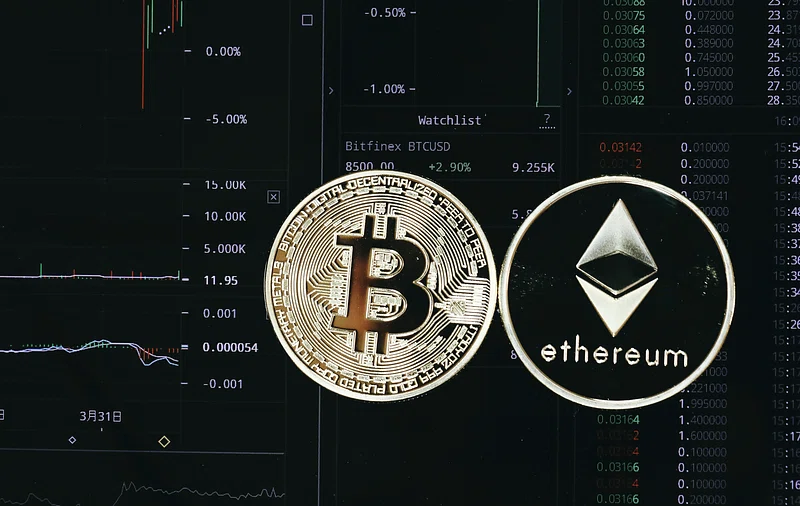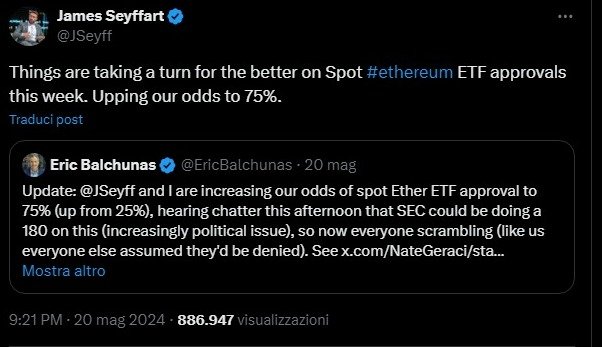THE UNEXPECTED ETF
Following the approval of the “spot” (physically replicating) ETF on Bitcoin on Wednesday, January 10, 2024, many crypto enthusiasts, institutional traders, market analysts, and so on expected that the approval of the spot ETF on Ethereum (ETH), the world’s second most capitalized cryptocurrency, would take a biblical amount of time. After all, the Chigago Merchantile Exchange (CME) launched the futures ETF on Bitcoin back on Dec. 18, 2017, and since that date it has taken about six years to see a spot ETF on Bitcoin.
From the moment the spot ETF on Bitcoin was approved in early 2024 in the United States, the crypto sector has taken a quantum leap from the perspective of the legitimacy of the assets themselves; it also means that physical replication ETFs have been “cleared” in the eyes of regulators in the rest of the world (although it must be said that similar instruments have been available on some European exchanges for a few years now), so no one expected to have to wait for another 6 years for the ETF on Ethereum, but neither did anyone expect it to be approved even 6 months after the one on Bitcoin.
In fact, the market did not give the slightest chance of Security and Exchange Commission (SEC) approval to applications with a deadline of Thursday, May 23, 2024. That traders had either forgotten or were disappointed with Ethereum (ETH) was guessed by the poor performance of its price compared to that of Bitcoin’s price, which is the industry benchmark. As we can see from the ETHBTC chart, which is used to determine at any given moment which of the two prices performs better, the price of ETHUSD has been weaker than that of BTCUSD since September 2022, which is more than a year and a half.
The earliest date with a high probability of approval of the spot ETF on Ethereum, according to precisely those in the industry, would have been September 2024, since many believed it lacked the technical timeframe to approve it in May 2024.
Formally, the Ethereum ETFs that were approved on May 23, 2024 are similar to those on Bitcoin, so – to avoid redundancies – we defer the in-depth discussion of the process of forming a spot ETF to section 2 of the Bitcoin Spot ETF lesson.

Below we list the ETFs that received approval from the Financial Market Supervisory Authority in the United States on May 23, 2024:
- Grayscale Ethereum Trust and Bitwise Ethereum ETF, listed on NYSE Arca;
- iShares Ethereum Trust, listed on Nasdaq;
- VanEck Ethereum Trust, ARK 21Shares Ethereum ETF, Invesco Galaxy Ethereum ETF, Fidelity Ethereum Fund and Franklin Ethereum ETF, listed on CBOE BZX.
Although these are not physical replication funds, it is fair to mention here that Volatility Shares launched the first ETF on Etherereum 2x long (ETHT), which was listed on June 4, and the first Ethereum ETF 2x short (ETHD) was listed on June 7, both in the U.S. financial markets.
CHANGING OF THE GUARD
A rather curious event that occurred recently, which has gone unnoticed and may be related to the Ethereum spot ETF, consists of the resignation of Michael Sonnenshein, CEO of Grayscale, who will be replaced effective August 15 by Peter Mintzberg, a former Goldman Sachs executive.
The timing of this change at the top at a fund that, after years and years of trying, received the green light from the U.S. regulator to convert its trusts to open-ended ETFs leaves everybody with more questions than answers.
It should be pointed out that Grayscale’s profits will most likely drop due to competition (Wall Street financial institutions), as the fees charged by Grayscale for trading ETFs are much higher than those charged by traditional finance funds: in the case of the Bitcoin ETF, GBTC’s fees amount to 1.25 percent, while those charged by BlackRock are 0.25 percent.
Furthermore, it appears that Grayscale had to remove everything related to staking in its application to convert its Grayscale Ethereum Trust (symbol: $ETHE) into a spot ETF at the explicit request of the SEC. The SEC is concerned about investor protection, thus it fears that staking could generate liquidity problems in the fund, since staking involves locking ethers, purchased through the ETF, for a specified period of time.
CONTROVERSIAL APPROVAL
In Washington, D.C., the“Financial Innovation and Technology for the 21st Century Act” (FIT21) was passed on the day of May 22, 2024 with 279 votes in favor and 136 against, representing a significant step toward comprehensive regulation of digital assets in the United States.
FIT21 aims to delineate the regulatory responsibilities of the Securities and Exchange Commission and the Commodity Futures Trading Commission (CFTC) in the following way: the SEC will oversee digital assets classified as securities, while the CFTC will regulate commodities and derivatives.
In addition, the legislation includes robust retail investors protection measures designed to prevent fraud and market manipulation, including disclosure transparency requirements for issuers of digital assets.

A key requirement to be classified as a digital asset is a certain degree of decentralization, which is achieved if the issuer does not control the blockchain or protocol and if it does not own or influence more than 20 percent of the digital commodity tokens or its votes, among other requirements.
Although the law tries to draw a line between the CFTC’s and the SEC’s powers, it does not entirely succeed. For example, to be classified as a digital asset, its issuer must inform the SEC that it believes the digital asset is decentralized and provide the reasons why, and the SEC has 60 days to respond.
SEC Chairman Gary Gensler expressed his views on the law: the problem he pointed out is that digital assets are quite numerous; if hundreds or thousands of token issuers simultaneously made a decentralized statement, the SEC would not have the resources to examine them all, so they would automatically become digital assets that are potentially very risky for investors.
This could be problematic because digital commodities do not have a reporting requirement, while digital assets that fall under the category of restricted securities have a requirement to inform investors twice a year.
Congresswoman Maxime Waters also voiced her criticism: she pointed out that the CFTC was never meant to oversee retail investments. The CFTC has a staff of about 700, which is far less than the SEC’s approximately 5,000. Once a digital asset is classified as a “digital commodity,” the degree of supervision becomes quite limited, which could ease the supervision burden. In addition, once the digital asset becomes decentralized, instead of transferring investor disclosure requirements to the governance system, these are dropped.
The implicit goal of FIT21 is to circumvent the much-feared Howey test, under which the SEC classifies most digital assets as securities, so as to incentivize the entire crypto sector to grow without fear of being scrutinized, charged and legally prosecuted by the U.S. regulator.
Meanwhile, Coinbase is currently taking advantage of the situation to appeal the lawsuit against the SEC, citing the FIT21 vote of lawmakers, which has been going on since June 7, 2023, when the SEC sued Coinbase for listing and trading cryptocurrencies that the U.S. regulator said were unregistered securities.
UNUSUAL SPEED
The most plausible and widespread interpretation of the events just described seems to be that of a politically motivated maneuver. It almost seems as if 2024 is the year when Wall Street and Washington, D.C. have decided to legitimize the crypto sector, that is, to make it mainstream and integrate it into mainstream finance.
Supporting this idea is the fact that the Republican faction has certainly not stood idly by: Trump plans to create a sort of “crypto army.”
In any case, the timing with which all of this is happening could be explained by the fact that in November 2024 elections will be held in the United States, so the two parties are presumably trying to ingratiate themselves with that segment of the electorate that has become passionate about the crypto sector.
Very relevant is the fact that although spot ETFs on Ethereum were approved on May 23, 2024, they are not yet operational.
In fact, the SEC has approved Forms 19b-4 for Ethereum ETFs, which include applications from BlackRock, Fidelity, and Grayscale. For these products to begin trading, however, their S-1 registration statements must become effective.
In the United States, Forms 19b-4 and S-1 for ETFs play distinct roles in the approval and lacio process:
- Form 19b-4: consists of a request for approval to list and trade an ETF on a particular exchange pair (in this case ETHUSD); the content of the request includes the structural and operational characteristics of the ETF, such as its investment objective, rebalancing methodology, and associated costs.
- Form S-1: a document to be submitted by ETF issuers to the SEC at a later stage than Form 19b-4 and is used to officially register the ETF with the SEC; in the content, detailed information about the ETF should be provided, with more in-depth financial and legal aspects added.
In other words, Form 19b-4 focuses on obtaining permission to list an ETF, while Form S-1 finalizes its registration and full disclosure. However, approval of Form 19b-4 does not guarantee registration of the ETF, which precisely requires completion of Form S-1 and its approval by the SEC.
When the ETFs on Bitcoin were approved, the S-1 forms were ready before the 19b-4 approvals; therefore, the S-1 forms went into effect very quickly and trading began the day after approval.
For Ethereum ETFs, it is clear that the SEC did not engage with the issuers (the investment funds) in these months until political pressure began in mid-May; the issuers were able to quickly deliver Forms 19b-4.
On Wednesday, May 29, 2024, BlackRock made a request for its Form S-1. As a result, although spot ETFs on Ethereum have been approved, trading is likely to begin between late June and early July 2024.
The speed with which this affair is developing is so unusual that even analysts, opinion leaders, and financial observers cannot keep up with the news: at the beginning of the last week of May 2024 it was thought that the launch of the ETFs would take place in July; after some days it was reported by reliable sources that the launch will be brought forward to a period in mid- to late June.
THE PRE-APPROVAL MARKET REACTION
The straw that broke the camel’s back was represented by a couple of tweets from two analysts who have been following the development of both the Bitcoin and Ethereum ETF spots very closely.

As a result of these statements, the price of ETHUSD rose by 20 percent in a matter of hours, from about $3050 to $3700 during the evening of Monday, May 2024, then before the actual approval. There was indeed a dislocation of capital that was presumably corrected in the short term.
Reaching a local top at $3950 on the day of approval, Thursday, May 23, 2024, the price underwent a correction that brought it back to about $3700, suggesting that market participants are doubtful about what will happen at launch.
POST-APPROVAL MARKET SITUATION
In the days between the approval of the Ethereum spot ETFs and the actual launch, the market decided to keep the price of ETHUSD between $3950 and $3500, which is a price range of roughly 10 percent.
According to classical technical analysis, the break-out of the very strong $4000 resistance and its conversion to support would most likely give the green light for a sharp rise in the price toward the all-time high of $4850 reached in November 2021, similar to what happened to the price of Bitcoin after the launch of its ETFs.
Market participants are therefore wondering whether a Bitcoin-like episode will actually occur.
In fact, the situation of the cryptoasset founded in 2015 by Vitalik Buterin is slightly different from that of the quintessential digital gold: the amount of ether in the AUM (Asset Under Management) of the Grayscale Ethereum Trust (ETHE) is far less than that in the old Grayscale Bitcoin Trust (GBTC), so in theory the conversion of the trust to an open-ended ETF should not cause a supply shock with a massive increase in supply.
The data show that an amount of 2.96M ether could be sold in the market, which in dollars roughly amounts to $10B (priced at $3500 for 1 ETH). By itself, the figure is definitely smaller than the approximately $30B in bitcoin coins liquidated by GBTC, but Ethereum’s market capitalization is one-third of Bitcoin’s at the time of writing, so that 2.96M ether could still have a negative effect on the price in the short term.
DEMAND WILL BE DECISIVE
It will be necessary to keep an eye, once the ETFs are launched in the market, not only on the outflows of the Grayscale Ethereum Trust but also on the inflows of capital into the ETFs of Blackrock and the other funds; as is the case in most cases, the analysis of demand is the most important element of all, since it determines the success of the instrument that has just been introduced in the market and, above all, the potential for the price of the underlying asset to rise.
It will be interesting to understand what justification/narrative investors will find for investing in Ethereum spot ETFs, as Bitcoin is known to most as “digital gold,” while it is not so straightforward to find a valid reason easily understood by everyone why it makes sense to invest in Ethereum ETF.
In other words, investors’ age might be one more problem that Ethereum ETFs have to deal with as opposed to what happened with Bitcoin; we are basically talking about issues such as misunderstanding the underlying technology, since Ethereum is definitely more complicated than digital gold.

A good reason to invest could theoretically be to diversify the capital to allocate in the crypto sector to mitigate risk, but two problems arise: the first lies in the very high correlation between ETHUSD and BTCUSD, which makes diversification ineffective; the second lies in the fact that, in most cases, the capital to be invested in the ETH ETF would be moved from the Bitcoin ETF, as happens in a liquid placed in two communicating vessels, so there would be no net increase in the capitalization of the two cryptoassets.
The topic of artificial intelligence is worth mentioning here: having been on the lips of everyone from ordinary citizens to large investment fund managers for many months now, it could be argued that Ethereum and Bitcoin ETFs do not currently have much appeal. Essentially, capital has so far flowed into technology equities, e.g., Nvidia (NVDA), which benefit now and potentially in the future from this revolution, so the crypto sector has been largely sidelined by the AI narrative.
STAYING DECISIVE
At this point, given that support in the U.S. for the crypto sector is bipartisan and that the criteria for what constitutes a digital asset have been redefined by law, one can legitimately speculate on upcoming ETFs. However, one cannot take policy statements as guaranteed and safe because they could rapidly change in a different direction.
In the Anglo-Saxon legal system, the concept of following the precedent is a principle that is taken very seriously, so enthusiasts in the crypto market can start to wonder what the next cryptoassets or groups of cryptoassets will be that will be the subject of ETFs in the US, Europe and Asia.
For example, it would be very interesting to be able to invest in an ETF similar to SPX, i.e., an instrument that replicates the performance of the top 5 most capitalized cryptocurrencies in the sector.
UPDATES
On Wednesday, June 19, 2024, the SEC, in anticipation of the launch of Ethereum spot ETFs (ETH), publicly stated that it had closed its investigation, opened on Tuesday, March 28, 2023, into Ethereum 2.0, after the upgrade from PoW to PoS, but did not make any definitive statements on Ethereum’s formal status as an asset.
On Tuesday, 23 July 2024, exactly two months after approval by the SEC, the Ethereum spot ETFs were launched on the financial markets. List of ETH ETFs: Bitwise with AETH, Hashdex with ETHE11, iShares with ETHA, VanEck with EFUT, ProShares with EETH, Ark Invest/21Shares with ARKZ. The SEC also approved the conversion of the Grayscale Ethereum Trust into an ETF, i.e. ETHE.

